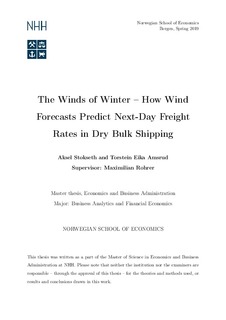The winds of winter : how wind forecasts predict next-day freight rates in dry bulk shipping
Master thesis
Permanent lenke
http://hdl.handle.net/11250/2612180Utgivelsesdato
2019Metadata
Vis full innførselSamlinger
- Master Thesis [4372]
Sammendrag
This thesis examines the short-run capesize dry bulk shipping market, where shipping
theory states that freight rates are driven by supply, as demand is inelastic. Transporting
cargo faster is an important way to increase supply if demand increases in the short run.
Market participants monitor the speed of the available fleet and form expectations of
future supply, and these expectations are key drivers of freight rates in the very short
run. Any factor affecting the speed of vessels will therefore have an impact on freight
rates. We combine local wind forecasts with positional vessel data, and show how wind
forces push vessels forwards and inflate their speed. Based on these findings, we propose
a novel positive wind force measure. We then show our positive wind force measure
predicts next-day freight rates. For a one standard deviation increase in the positive wind
force at average level, we find the next-day spot rate increases by 0.3% and the next-day
forward freight agreement (FFA) rate increases by 0.6%. Our measure helps shipowners
and charterers make better pricing decisions in the spot market, and hedge their exposure
better through the FFA market. Other traders can also profit in the FFA market, as we
show changes in our measure can predict changes in the FFA rate greater than transaction
costs.
